Pawscessories is reader-supported. When you buy via links on our site, we may earn an affiliate commission at no cost to you.
Learn more.
Do you want a large, loyal dog that is excellent with children and makes a great guard dog? If so, the Siberian Rottweiler may be the perfect breed for you!
However, when looking at the different Rottweilers, knowing which is best for you can be confusing. This is because there are many Rottweilers lineages, the German Rottweiler, American Rottweiler, Russian Rottweiler, and Siberian Rottweiler.
It might seem like these Rottweilers are just named based on where they were born, but each has their own distinct set of characteristics that sets them apart.
In this guide, we will take a look at the history of this breed, what’s unique about them, why they differ from other Rottweilers, their physical appearance, temperament, and common FAQ’s about them.
Let’s take a closer look at this fascinating breed!
Table of Contents
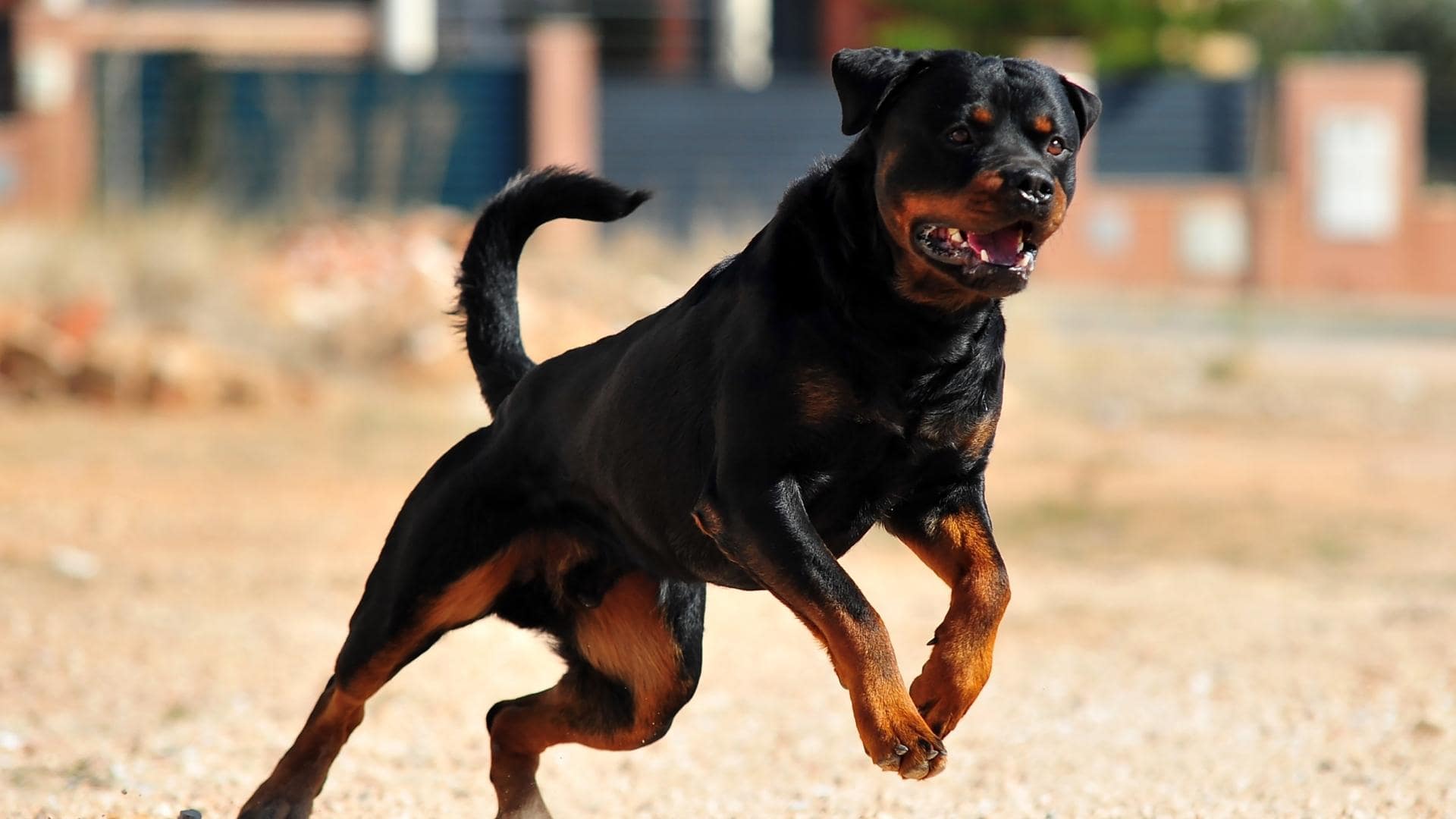
What Is A Siberian Rottweiler?
The Siberian Rottweiler is just a Rottweiler with a different breed lineage. Since it comes from a separate breed line born and bred in Serbia, it has unique differences and character traits.
It’s the same reason American Rottweilers with American lineage and German Rottweilers with German lineage also have differences.
The Siberian Rottweiler is a large, powerful dog with a broad head and a strong, muscular body. They have a thick coat that can be either short or long and comes in various colors, including black, brown, and tan.
These dogs are known for being fiercely loyal and protective of their family and make excellent guard dogs. They are also gentle, loving, and great with children, which makes them a perfect family pet.
History Of The Siberian Rottweiler
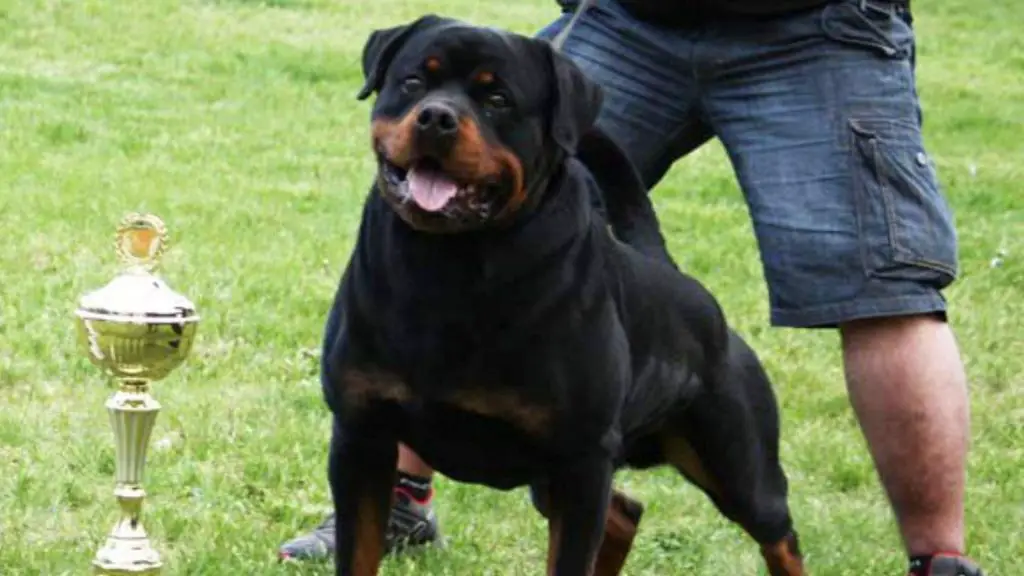
The Rottweiler breed has a long history dating back to ancient Rome. They were originally bred as working dogs, and today they are still used as police, therapy, and search and rescue dogs.
The Rottweiler breed is among America’s top 10 most popular dog breeds. Over time the Rottweiler spread into other parts of the world, including Siberia.
When the Rottweiler was bred in different parts of the world, it developed slightly different from Rottweilers in other locations. The environment in which they were bred, the climate, what the breeders wanted them to be like, and even the food they ate shaped how this lineage developed.
This is why we have slight differences in American, German, and Serbian Rottweilers. Each of these Rottweilers can be traced back to where they originated.
For example, the purebred Siberian Rottweiler can be traced all the way back to a dog born in Serbia.
Siberian Rottweilers were bred to have block-shaped heads, a short muzzle, and a stocky build. This differs slightly from the original Rottweiler breed, which was bred to have a longer muzzle and leaner physique.
Why Is There Controversy With The Serbian Rottweilers?
There always seems to be controversy when it comes to purebred dog breeding.
Since different countries can develop different breed standards, it can cause confusion when two countries want the dogs to have different appearances and temperaments.
With the Siberian Rottweiler, there is no set standard for this dog breed, making it difficult to predict the appearance and temperament of each dog.
This is why some people are hesitant about this breed because you never know what you’ll get. But if you research and find a reputable breeder, you shouldn’t have any problems.
Siberian Rottweilers are considered to have “faults” and do not meet the breed standards of the AKC (American Kennel Club) or the ADRK (German Rottweiler Club). This creates controversy because some people believe they are not a “proper” Rottweiler, while others do.
However, some Serbian Rottweilers don’t have these faults and meet standards. It just might not be clear which type of Rottweiler you have. Some Serbian Rottweiler breeders will use German Rottweilers to get their desired look.
What Makes The Serbian Rottweiler Special?
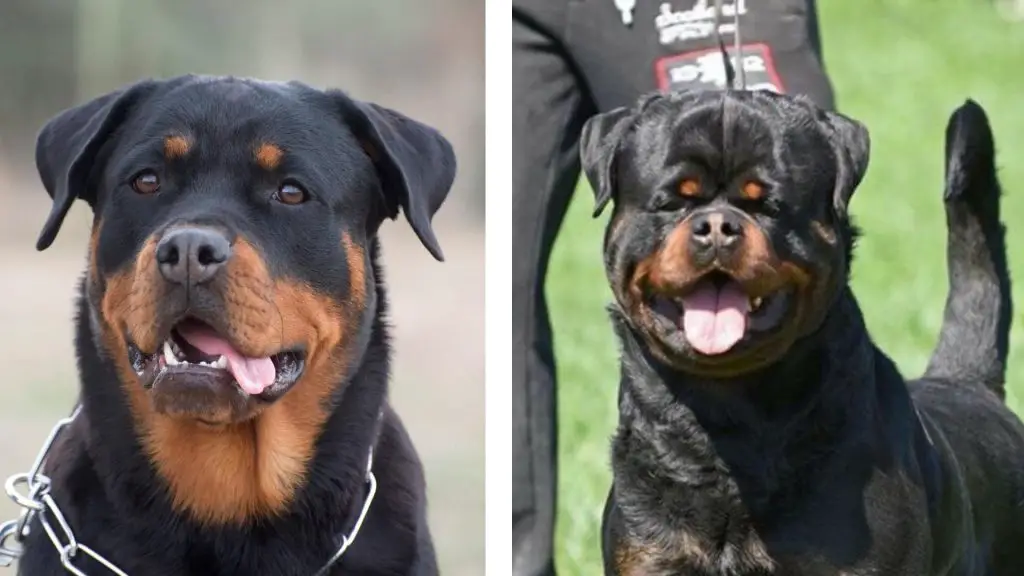
The Serbian Rottweiler is a special breed because it has unique physical traits and character traits that make it different from other Rottweilers.
This breed is known for being fiercely loyal, loving, and protective, which makes them an excellent family pet. They are also great with children.
The Siberian Rottweiler is a large, powerful dog with a broad head and a strong, muscular body. They have a large blocky head with a short snout.
In addition, they tend to be more wrinkly with deep-set eyes compared to other Rotties.
They are often heavier with a slightly sloped back. Some would describe them as having a tube-shaped body.
Let’s dive into more details, specifically about the Serbian Rotty and how they compare to German and American Rottweilers.
Serbian Rottweiler Breed Information
Here is more detailed information on the Serbian Rottweiler breed and what you can expect if you choose to add one of these special dogs to your family.
Serbian Rottweiler Temperament & Behavior
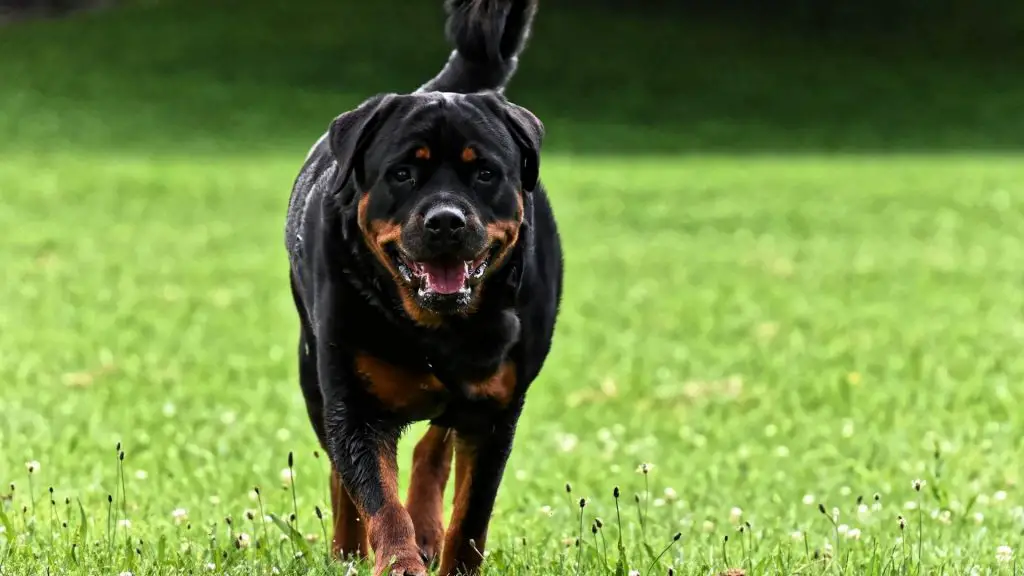
Since there is no set standard for the Siberian Rottweiler temperament, it can be hard to predict how each individual dog will behave.
However, in general, Serbian Rottweilers are known for being fiercely loyal, loving, and protective of their family. They are also great with children, which makes them an excellent family pet.
They have a strong prey drive and will need a lot of exercise to burn off energy. This breed is not for everyone and does require an active lifestyle.
Their tendency to protect their loved ones also makes them excellent guard dogs.
Serbian Rottweiler Appearance & Traits
The Siberian Rottweiler is a large, powerful dog with a broad head and a strong, muscular body. They have a sizeable blocky head with a short snout.
In addition, they are slightly wrinkled with a deep set of eyes compared to other Rotties. Their eyes are usually dark brown.
They often have a sloped back with a tube-shaped body.
They are hefty dogs which gives them a much bulkier appearance. Their short double coat is straight and coarse. It’s usually black with mahogany, tan, or brown patches. However, some rare Rottweilers like Blue Rottweilers and Red Rottweilers exsist.
Serbian Rottweiler Weight & Height
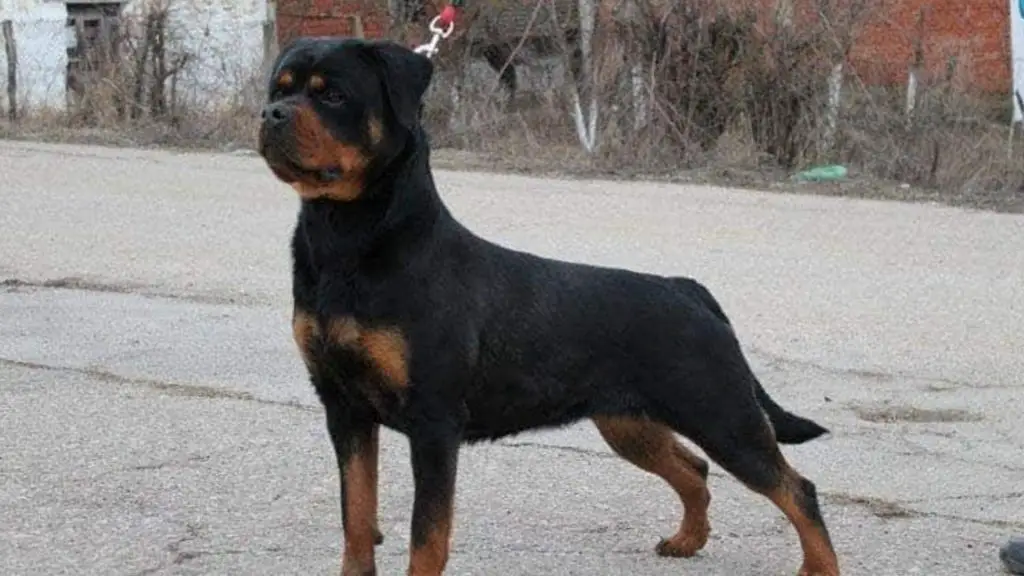
Siberian Rottweilers are generally larger than other rottweilers weighing between 143 to 152 pounds, and stand anywhere from 22 to 27 inches tall at the shoulder.
The Average German and American Rottweiler are 110 to 132 pounds and are about the same height. So as you can see, there can be about a 30-pound weight difference between the Rottweilers.
Shedding & Grooming
The Serbian Rottweiler is a moderate shedder most of the time. However, they turn into heavy shedders during the shedding season (spring & fall).
They have a short, thick coat that is easy to groom. Weekly brushing with a stiff-bristled brush is all that’s needed to remove loose hair and keep their coat healthy and clean.
Trimming nails monthly, cleaning their ears, and brushing their teeth regularly will also help maintain their overall health.
Are Serbian Rottweilers Hypoallergenic?
No, Serbian Rottweilers are not hypoallergenic. However, they shed and produce a large amount of dander which means they are not a good choice for people with allergies.
Serbian Rottweiler Lifespan
The average lifespan of a Siberian Rottweiler is between 8 to 10 years.
This is about the same as the German and American Rottweiler. The best way to ensure a dog lives a long, healthy life is by feeding them a nutritious diet, providing plenty of exercise, and regularly taking them to the vet for checkups.
Serbian Rottweiler Common Health Issues
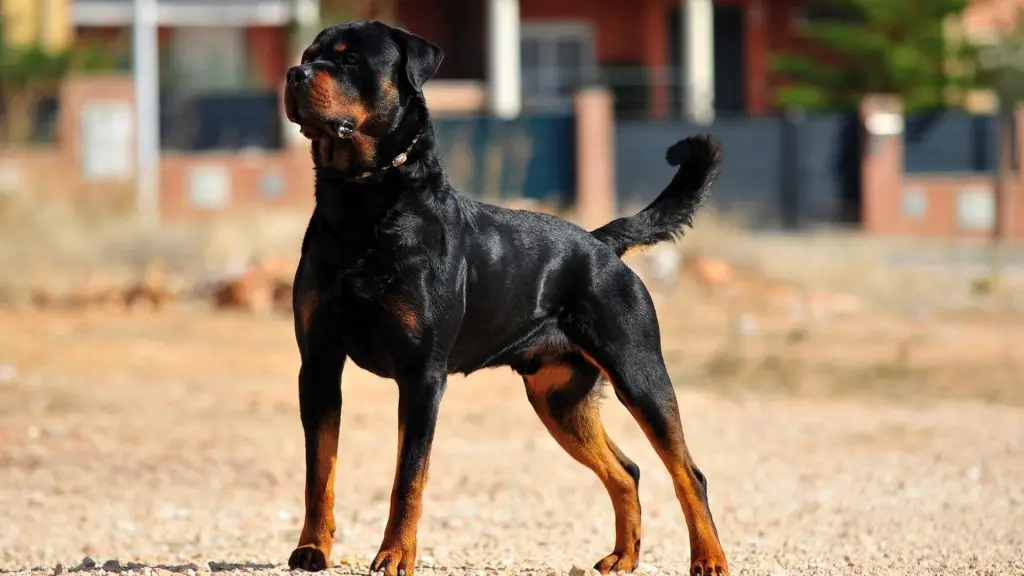
The Siberian Rottweiler is generally a healthy breed with no severe health concerns.
However, like all breeds, they are susceptible to developing specific health concerns. The Serbian Rottweiler shares much of the same health concerns as the German and American Rottweilers.
But since the Serbian Rottweiler breeding is less standardized, this can open up potential health issues in this Rottweiler lineage.
Without careful evaluation of a dog’s genome within the lineage, some heritable health and temperament issues can slip by. But with that said, this doesn’t mean the Serbian Rottie is always going to have these risks.
Here are some possible health concerns for the Serbian Rottweiler:
Hip & Elbow Dysplasia
This is a condition where the bones in the joints don’t fit together correctly, which leads to pain, lameness, and arthritis. Since the Serbian Rottweiler is heavier than the average Rottweiler, they can be more susceptible to joint issues.
Cancer
Cancer is the leading cause of death in dogs, and Siberian Rottweilers are no exception. While there is no guarantee a dog will or will not get cancer, there are certain things that can increase the chances, such as:
- Being overweight or obese
- Not getting enough exercise
- Exposure to toxins such as cigarette smoke
- A diet high in processed foods
- Genetic predisposition
JLPP
Also referred to as Polyneuropathy with Ocular Abnormalities and Neuronal Vacuolation (POANV). JLPP is a disease that causes neurological problems and can be fatal. It causes obstruction of airflow to the lungs and weakness. This nervous system deterioration is caused by a mutation in the SOD-I gene. Many Rottweiler breeders will take DNA tests to ensure this does not pass on to the puppies.
Cardiac Disease
The Siberian Rottweiler is also prone to developing a cardiac disease. The most common type is Dilated Cardiomyopathy, a disease of the heart muscle that leads to an enlarged heart and eventually heart failure.
Respiratory Problems
Since the Serbian Rottweiler has a shorter muzzle, it’s possible they could suffer from respiratory issues. However, as full disclosure, this is speculative since there is no proof this is true (yet).
Other dogs with short muzzles, such as the Boxer and the Boston Terrier, have been shown to suffer from respiratory problems, so it’s possible the Serbian Rottweiler could as well.
Serbian Rottweiler Trainability & Intelligence
The Serbian Rottweiler is an intelligent breed that is easy to train.
This isn’t surprising given the Rottweiler’s history as a working dog.
However, they can also be headstrong and stubborn, so early training is essential when they are young. Consistency, patience, and positive reinforcement are key when training any dog, but especially a Rottweiler.
Serbian Rottweilers make great guard dogs and protectors. They are also excellent at obedience, agility, tracking, and herding.
If you’re looking for a loyal, obedient, and intelligent breed, then the Serbian Rottweiler.
Serbian Rottweiler Activity Level & Exercise Needs
If you know anything about the Rottweiler breed, then you know they need plenty of exercise.
The Siberian Rottweiler is no exception. They need at least an hour of exercise daily, although more is always better.
A daily walk is a great way to get them the exercise they need, but they also love to run and play. If you don’t have time for a daily walk, consider hiring a dog walker or taking them to doggy daycare.
A tired dog is a good dog. You can also give them plenty of stimulating toys and puzzles to help stimulate them on those days you can’t walk them.
What Is The Price Of A Serbian Rottweiler?

You’ll soon discover a lot of convoluted terminology surrounding Rottweilers since they’re such hot topics nowadays.
So when looking for one to buy, you will come across German, American, Serbian, European, Australian, and Russian Rottweiler breeders. Some even specialize in hybrid dog breeding between the different Rottweilers.
Where you buy one, the breeder, coat color, etc., will all play a role in the price of a Rottweiler.
Generally, a Serbian Rottweiler will cost anywhere from $1000 to $4000. Some even go for as high as $5000+ if they come from a solid bloodline. In America, the average Rottweiler Puppy is roughly $1500.
Be very careful when you see a Rottweiler puppy going for low prices.
The average price is around $1500 – $2000, so if you find a $500 Rottweiler for sale, be extremely cautious. Do your research and ensure you get a healthy dog from a reputable breeder.
Serbian Rottweiler Vs. German Rottweiler
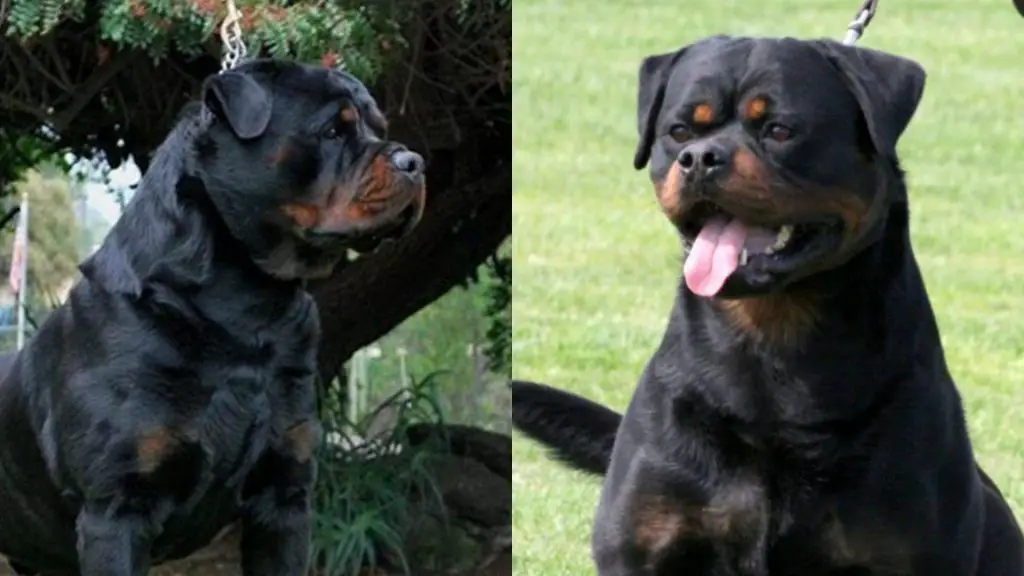
There are some key differences when looking at the Serbian and German Rottweilers.
The Serbian Rottweiler is said to be larger than the German Rottweiler.
Serbian Rottweilers are bred to have shorter faces and blockier heads. They are also built to be stocky and larger than the German Rottweiler. In addition, the German Rottweilers are still bred based around the ADRK (German Rottweiler club) standards.
This means the German Rottweilers will generally be leaner without the Serbian Rotty’s stocky look and block-shaped head. They will also contain fewer wrinkles and a longer muzzle.
The Serbian Rotties can also have sloped backs, which is a disqualifying fault in the German Rottweiler standard.
Here are a list of faults taken from the ADRK website that could disqualify some Serbian Rottweilers:
- General appearance: Light, weedy, leggy appearance. Light in bone and muscle.
- Head: Hound-type head. Narrow, light, too short, long, coarse or excessively molossoid head; excessively broad skull, (lack of stop, too little stop or too strong stop). Very deep frontal groove.
- Foreface: Long, pointed or too short muzzle (any muzzle shorter than 40 percent of the length of the head is too short); split nose; Roman nose (convex nasal bridge) or dish-faced (concave nasal bridge); acquiline nose; pale or spotted nose (butterfly nose).
- Body: Too long, too short or too narrow.
- Back: Too long, weak; sway-back or roach back.
- Forequarters: Narrow, crooked or not parallel standing front legs. Steep shoulder placement. Loose or out at elbow. Too long, too short or too straight in upper arm. Weak or steep pastern. Splayed feet. Too flat or too arched toes. Deformed toes. Light coloured nails.
- Skin: Wrinkles on head.
- General appearance: Too molossoid type and heavy general appearance.
- Skin: Skin at the head strongly wrinkled, strong wrinkles in the area of the forehead, the muzzle and the cheeks, strong dewlap.
- Gait: Sluggish action while trotting.
Not all Serbian Rottweilers will have all of these faults, but it’s important to be aware of them.
If we shift over to comparing their temperament, the only real difference is that Serbian Rottweilers can be more aggressive and temperamental. This is mainly because the German Rottweiler breeders stick to a strict standard which the Serbian Rottweiler breeders do not.
Of course, this mainly depends on the dog’s parents and their lineage; not all Serbian Rottweilers will be more aggressive and temperamental.
Other Frequently Asked Questions
Which Type Of Rottweiler Is The Best?
The answer to this question is subjective and depends on what you are looking for in a Rottweiler. For example, some people prefer the Serbian Rottweiler for its unique look and blocky head. In contrast, others may prefer the American Rottweiler for its athletic build. Ultimately, it is up to you to decide which type of Rottweiler is the best for you and your family.
All Rottweilers can be fantastic dogs; just make sure you get them from a reputable breeder to avoid any issues with their health or temperament.
In addition, make sure to socialize and train them from a young age.
Are Serbian Rottweilers Good?
Yes, Serbian Rottweilers can be good dogs if raised and trained correctly. They are a large breed of dog, so they need plenty of exercise and socialization to prevent them from becoming destructive.
With the proper care and training, Serbian Rottweilers can make great family pets. Make sure you are prepared to handle their high energy levels and large size.
Final Thoughts
In conclusion, the Siberian Rottweiler is a large and powerful dog that has a lot of love to give.
They may have slight differences compared to the American and German Rottweiler. However, they are still the same big softies at heart. Suppose you are looking for a gentle giant to add to your family. In that case, the Siberian Rottweiler may be the perfect breed for you.
Just make sure you do your research and get them from a reputable breeder. This is the most critical step to take when getting a puppy. It can be the difference between getting a healthy dog, one with health issues, one with behavior problems, or one without any issues.
Other posts you might find interesting:
Great Dane Rottweiler Mix (AKA Weiler Dane): Breed Profile
Australian Shepherd Rottweiler Mix (AKA The Aussie Rottie Mix)
